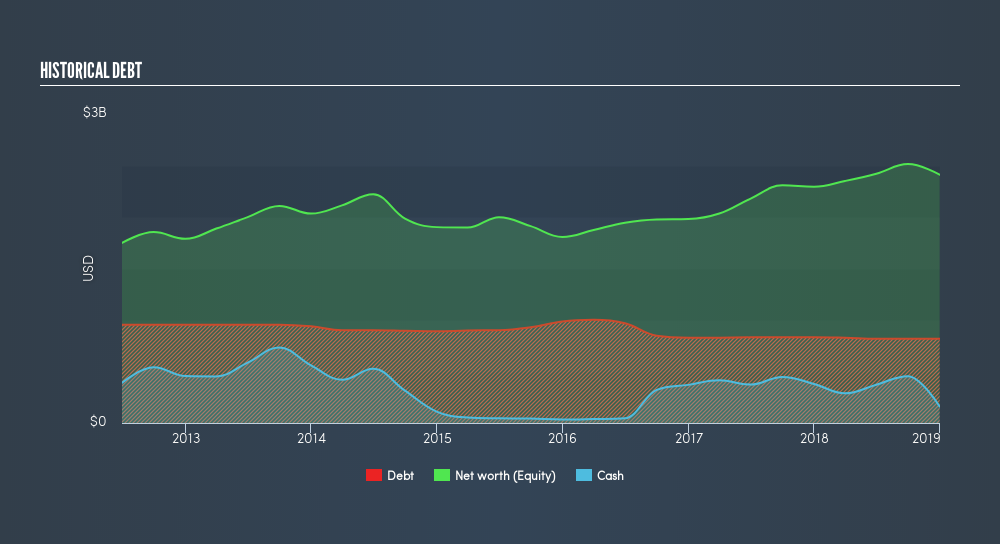- United States
- /
- Machinery
- /
- NYSE:OSK
Is Oshkosh Corporation (NYSE:OSK) As Strong As Its Balance Sheet Indicates?

Mid-caps stocks, like Oshkosh Corporation (NYSE:OSK) with a market capitalization of US$5.6b, aren’t the focus of most investors who prefer to direct their investments towards either large-cap or small-cap stocks. However, generally ignored mid-caps have historically delivered better risk-adjusted returns than the two other categories of stocks. Let’s take a look at OSK’s debt concentration and assess their financial liquidity to get an idea of their ability to fund strategic acquisitions and grow through cyclical pressures. Note that this commentary is very high-level and solely focused on financial health, so I suggest you dig deeper yourself into OSK here.
See our latest analysis for Oshkosh
OSK’s Debt (And Cash Flows)
OSK has sustained its debt level by about US$818m over the last 12 months which accounts for long term debt. At this constant level of debt, OSK currently has US$160m remaining in cash and short-term investments to keep the business going. On top of this, OSK has generated US$321m in operating cash flow in the last twelve months, resulting in an operating cash to total debt ratio of 39%, meaning that OSK’s current level of operating cash is high enough to cover debt.
Can OSK meet its short-term obligations with the cash in hand?
Looking at OSK’s US$1.5b in current liabilities, it seems that the business has been able to meet these obligations given the level of current assets of US$2.9b, with a current ratio of 1.99x. The current ratio is the number you get when you divide current assets by current liabilities. Generally, for Machinery companies, this is a reasonable ratio as there's enough of a cash buffer without holding too much capital in low return investments.

Can OSK service its debt comfortably?
With a debt-to-equity ratio of 34%, OSK's debt level may be seen as prudent. OSK is not taking on too much debt commitment, which can be restrictive and risky for equity-holders. We can check to see whether OSK is able to meet its debt obligations by looking at the net interest coverage ratio. A company generating earnings before interest and tax (EBIT) at least three times its net interest payments is considered financially sound. In OSK's, case, the ratio of 13.8x suggests that interest is comfortably covered, which means that debtors may be willing to loan the company more money, giving OSK ample headroom to grow its debt facilities.
Next Steps:
OSK has demonstrated its ability to generate sufficient levels of cash flow, while its debt hovers at an appropriate level. In addition to this, the company exhibits proper management of current assets and upcoming liabilities. This is only a rough assessment of financial health, and I'm sure OSK has company-specific issues impacting its capital structure decisions. I suggest you continue to research Oshkosh to get a more holistic view of the stock by looking at:
- Future Outlook: What are well-informed industry analysts predicting for OSK’s future growth? Take a look at our free research report of analyst consensus for OSK’s outlook.
- Valuation: What is OSK worth today? Is the stock undervalued, even when its growth outlook is factored into its intrinsic value? The intrinsic value infographic in our free research report helps visualize whether OSK is currently mispriced by the market.
- Other High-Performing Stocks: Are there other stocks that provide better prospects with proven track records? Explore our free list of these great stocks here.
We aim to bring you long-term focused research analysis driven by fundamental data. Note that our analysis may not factor in the latest price-sensitive company announcements or qualitative material.
If you spot an error that warrants correction, please contact the editor at editorial-team@simplywallst.com. This article by Simply Wall St is general in nature. It does not constitute a recommendation to buy or sell any stock, and does not take account of your objectives, or your financial situation. Simply Wall St has no position in the stocks mentioned. Thank you for reading.
About NYSE:OSK
Undervalued with excellent balance sheet and pays a dividend.
Similar Companies
Market Insights
Community Narratives


